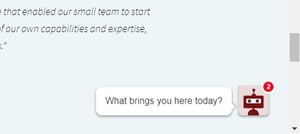Conversational Marketing Produces Results — Fast Results And Sales-Ready Results

Besides being a new label created by marketing people for marketing people, conversational marketing is the application of chat technology that allows your prospects the option to get an immediate response from you to converse with your team in real time.
This technology is not new. Most of us have had unremarkable chat experiences online, and because of this, for years we advised clients away from online chat simply because we knew the experience was going to be horrible.
But today’s chat tools allow bots and advanced artificial intelligence (AI) to make the experience productive. Be warned: Plenty of bad chat experiences are still out there. I had a few this weekend from software companies, but people have figured out how to leverage chat to drive business results for sales, marketing and customer service.
What Are Chatbots?
An article from Inc. Magazine describes chatbots as computer programs that “respond to texts or digital chats, effectively carrying on quasi-conversations with the humans (your current and potential customers) on the other end. Thanks to advances in natural language processing (NLP) and artificial intelligence (AI), these bots have stronger conversation abilities than ever before.”
You’ve likely seen them on more and more websites. Here’s a pic of the chatbot on the Square 2 site.

How Chatbots Work
Chat technology works in two ways. The first and most obvious is when a visitor to your site engages with your chatbot, live people behind the scenes are notified and engage directly with the visitor.
This could be sales reps, inside sales teams, marketing people or new business reps. They can answer questions directly, engage in sales conversations, attempt to qualify and move prospects into active sales conversations.
Conversational marketing caution: Tread lightly, salespeople. Just like when you visit a retail store and salespeople attack you before you make it three steps into the store, that gut instinct you get to fend off salespeople is the same feeling your prospects are going to get if you put the hard sell on via chat.
What can you do for them? How can you help them? Why are they here and what are they looking for? Let them decide how and when they want to engage with you. If they only have a simple question and you can answer it, mission accomplished.
Some chat tools allow you to assign reps to contacts in your CRM, and when the assigned contact visits the site, the assigned rep is contacted. This keeps the continuity of the sales process intact. It also allows the rep to continue the personal and highly customized sales process via chat.
But there is another way chatbots work when no one is around. According to an article published by WordStream, “At the heart of chatbot technology lies natural language processing, or NLP, the same technology that forms the basis of the voice recognition systems used by virtual assistants such as Google Now, Apple’s Siri and Microsoft’s Cortana.
Chatbots process or parse the text presented to them by the user, before responding according to a complex series of algorithms that interprets and identifies what the user said, infers what they mean and/or want and determine a series of appropriate responses based on this information.
Some chatbots offer a remarkably authentic conversational experience, in which it’s very difficult to determine whether the agent is a bot or a human being.
[But] this is where most applications of NLP struggle, and not just chatbots. Any system or application that relies upon a machine’s ability to parse human speech is likely to struggle with the complexities inherent in elements of speech such as metaphors and similes.
Despite these considerable limitations, chatbots are becoming increasingly sophisticated, responsive and more 'natural.' Put another way, they’re becoming more human.”
Why Chatbots Are Effective
If we go back in time (just a few years), the only way to get anyone’s attention on a website was to fill out a form. Generally, the form required visitors to provide contact information and then wait for their request to be serviced up, usually via email.
Of course, the phones still work, and most sites include phone numbers, but people don’t want to make a call. They want to stay anonymous, if possible. The form-fill process took time and added friction to the engagement process.
Chat technology removes the need for the form-fill process and the phone call. If you want to talk to someone right now, simply chat with them. Similar to texting and instant messaging, it’s not surprising that usage of the chat feature was high, because people want to anonymously and instantly converse.
While human behavior caught up to chat, the chat technology also progressed. Gone are the old days when you would chat and get no reply. Today, advanced artificial intelligence powers a lot of the chat tools and allows the tool itself to converse with your prospects, taking the human error and mismanagement aspect out of chat.
Now, prospects can be engaged with instantly 24 hours a day, seven days a week.
How To Apply Chatbot Technology
You have several ways to use chat technology and conversational marketing to increase the number of leads, the number of sales opportunities and the quality of your website visitors’ experience on your site.
Beyond the obvious (giving your prospects direct access to your sales and/or marketing team to answer questions in real time on your site), here are some other applications that all add huge value.
You can get visitors’ intent data. Google is looking for content that satisfies searchers’ needs, so when people visit a site page and click to other pages or click to download, it’s a signal to Google that your page did what it promised. This helps it rank.
Knowing your visitors are finding what they intended when they landed on your pages is huge. Knowing they thought they’d find something else here is even bigger because it identifies a disconnect that you can fix.
Ask visitors if they found what they were looking for. Ask them what they were looking for. This is highly valuable chat data to collect.
Skip the form. One of the big value propositions from the chat software companies is an easier and frictionless sales process. By allowing visitors to directly engage with reps, they don’t have to fill out a form, give their contact information or request any information. They can simply chat with a sales rep.
This gives the reps a chance to qualify, engage and quickly move prospects through some early stages of the Cyclonic Buyer Journey™. In some cases, prospects who engage like this are working through an accelerated buyer journey, and it could be a signal that they are more active and more likely to close faster.
Finally, you can use chatbots to ask visitors questions. Ask questions that can be used for primary research. Ask questions that you can use to upgrade your website experience. Ask questions that you can use to qualify your visitors in the CRM because all of this data (if you set up your chatbot properly) is going to be associated with that prospect’s record in your marketing automation or CRM software.
If that sounds challenging or above your pay grade, consider a marketing operations (MOPS) role or support from an agency with these services. This is easy for them to help you set up, monitor and support going forward.
How To Select Which Chatbots Are Right For You
Without even trying, I can come up with 10 different chat tools available for consideration. HubSpot has its own chat tool built into its marketing automation product. Drift is a chat tool we recommend for companies that need advanced chat capabilities. ApexChat, Intercom, LiveChat and others also offer chat tools.
When it comes to selecting a chat tool, understand your requirements first. What do you want to do with it? How is it going to make your visitors’ experience better? How are you planning on using it in the sales and marketing process?
If you’re not sure, that’s fine. But you shouldn’t plan on investing a big part of your MarTech budget on it either. Try something for free. Run some experiments and get comfortable with the application. Get it producing results and then consider looking for an upgraded product.
If you have advanced requirements (either software-related, like you must integrate with Marketo or Salesforce.com, or around functionality), you should consider something more robust and be prepared to pay for it. Drift has a lot of advanced features and costs around $500 a month. That’s not much if you get a ton of leads through chat, but if you’re just playing around, less expensive options are available.
How To Gauge The Effectiveness Of Chat And Conversational Marketing
Finally, the $100,000 questions: How do we know if it’s working? How do we know the ROI? What are we getting from it?
If you set it up right, this should not be hard. You should be able to quickly get data on the number of sessions you’re having per week or per month and the types of sessions.
Then, what happens next? Are those sessions turning into sales opportunities, and if so, at what pace? It’s possible you’re getting good sessions, but sales is fumbling the transition.
Finally, track those contacts through your sales process. Are they becoming active sales opportunities? Are they closing? What is the sales cycle for chat-originated leads? Is it shorter than form-fill origination leads?
All of this data should be easy to generate and report on. Then you can make solid decisions based on the data. I would give any chat tactic at least three months to gain traction before making any decisions around the tool. Anything less would likely produce inconclusive findings.
To chat or not to chat? Definitely try chat. It’s moving in the direction of a trend, it improves the experience on your website and it accelerates lead flow. There are too many positives to ignore this marketing and sales tactic any longer.
